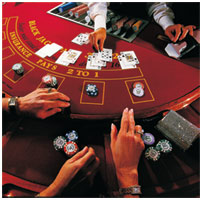Casinos pose a particular set of technical challenges for video security system designers. Achieving a particular ambience is important but so are fairness and security, and that means choosing security equipment which is up to the task. As in any purchasing situation, it helps to know what is available and what to look out for, so you can ask the right questions. In this article Geutebruck provides a checklist of relevant properties and considerations based on its experience in equipping many European casinos.
Casinos pose a particular set of technical challenges for video security system designers. Achieving a particular ambience is important but so are fairness and security, and that means choosing security equipment which is up to the task. As in any purchasing situation, it helps to know what is available and what to look out for, so you can ask the right questions. In this article Geutebruck provides a checklist of relevant properties and considerations based on its experience in equipping many European casinos.
● A dozen desirable video system features and benefits
If it is to ensure fair play for all its guests, the fulfilment of its legal obligations as well as its continued existence as a business, a casino has to provide security in all areas of its operation. This means providing security behind the scenes as well as front of house: for instance to protect staff who handle large sums in chips or cash, inside and outside business hours, as well as those who deal with guests. So it is no surprise that continuous, seamless video monitoring is an important element in any casino's security concept, and in many countries it is a strictly regulated legal requirement.

Casinos pose a particular set of technical challenges for video security system designers: Their lighting may be more atmospheric than camera-friendly, yet they need sharp, detail-rich pictures so that exact positions as well as colour and numbers of chips and cards can be verified. Fast, efficient display and operating functions are crucial to give supervisors instant access to recorded and live images to enable disputes to be settled immediately and unequivocally so play can continue. And last but not least, casinos need large storage capacities for retaining high quality, high frame rate video for as much as 30 days.
Nowadays, video surveillance systems go a long way to providing casinos with the ideal solution. But if you are buying it helps to know what to look for, so you can ask the right questions. This checklist of relevant properties and considerations is based on Geutebruck's experience in equipping many European casinos.
● Management of events or gaming tables is what casinos need, not just the management of individual cameras. Systems with intuitive, site-plan-based control screens now provide the ability to jump backwards in time, produce multicamera footage and send it over the network to a review station – all with a single mouse click.
.jpg) ● A flexible control interface which can be set up to meet every aspect of your requirements will provide the fastest possible access to the right images and ensure continuity of gaming.
● A flexible control interface which can be set up to meet every aspect of your requirements will provide the fastest possible access to the right images and ensure continuity of gaming.
● Adequate retention time and quality. If you invest heavily in recording and storage it makes no sense to skimp on image quality or retrieval features. You need to see the card or chip in detail, and have fast, easy access to sharp pictures.
● Support for analog, IP and megapixel cameras. Besides analog and network cameras, some hybrid systems also support megapixel network cameras. With 25 fps real-time viewing and recording, high resolution snapshots and digital zooming for close-ups, this can reduce the overall number of cameras needed. Identical system handling and common functionality for network and analog cameras (e.g. multiple viewer, synchronised playback of analog streams and IP images) enables the seamless integration of legacy equipment with easy operation and cost savings. On the other hand legacy analog cameras can also be integrated into IP solutions, using encoders with intelligent video management to provide high functionality and minimize network loading.
.jpg) ● The ability to set the image format for each camera to 4CIF, 2CIF or other option is a big plus where PAL/NTSC line interlacing cameras are used. Here, fast movement causes blurring, and storing blurred images at 4CIF resolution rather than 2CIF only wastes storage space. A better strategy is to use a system where you can select the optimum format for each scene and avoid using 4CIF where there is lots of movement.
● The ability to set the image format for each camera to 4CIF, 2CIF or other option is a big plus where PAL/NTSC line interlacing cameras are used. Here, fast movement causes blurring, and storing blurred images at 4CIF resolution rather than 2CIF only wastes storage space. A better strategy is to use a system where you can select the optimum format for each scene and avoid using 4CIF where there is lots of movement.
● Choosing the optimum compression process. Algorithms such as MPEG2 and MPEG 4/H.264 were developed for multimedia applications, and exhibit some weaknesses in video surveillance systems. For instance, there can be image distortion with high compression and movement; they may discard data which is not visible in real-time, but which could be vital in surveillance frame by frame analysis; recorded footage is easy to manipulate using multimedia special effects editors, even if “protected” with digital watermarking. So it's worth noting that a surveillance-oriented compression process may deliver better overall performance and efficiency. Geutebruck's MPEG4CCTV for instance maintains a fixed image quality whatever the content, varies the data stream with the level of movement, and retains all useful information for frame by frame analysis.
● Dynamic live streaming dynamically adjusts each video stream as it is produced, to suit the image size currently required for display. This minimises loading in networks and on hardware, and reduces the number of display servers required.
 ● Dual streaming separates recording quality streams from live viewing quality streams, allowing bandwidth reduction without loss of high quality footage.
● Dual streaming separates recording quality streams from live viewing quality streams, allowing bandwidth reduction without loss of high quality footage.
● 24/7 recording: To reconstruct disputed situations a recording speed of 25 fps is required during business hours, but a lower frame rate can be used out of hours to minimise storage costs.
● Assurance that the right scenes are recorded. Internal monitoring systems now constantly check camera status, image quality, lighting and position, and automatically trigger an alarm if tampering is detected. This prevents anyone deflecting cameras away from illicit activity.
● Redundancy for high availability. For most casinos not only do video system breakdowns mean lost gaming and lost revenue, but the fact that cash-counting and other security-sensitive operations continue out of hours means that maintenance windows are short. So no surprise that high reliability is high priority. Nowadays this can be delivered by clustered, modular server hardware with multiple  virtual servers and high availability raid 6 storage as in the IP solution Geutebruck exhibited at CeBit 2009 and which since went into service in a large casino. In addition, remote monitoring service centers now reduce the need for on-site maintenance by enabling both routine servicing and immediate remedies to be implemented remotely.
virtual servers and high availability raid 6 storage as in the IP solution Geutebruck exhibited at CeBit 2009 and which since went into service in a large casino. In addition, remote monitoring service centers now reduce the need for on-site maintenance by enabling both routine servicing and immediate remedies to be implemented remotely.
● Lower power consumption. The latest IP solutions offer considerable energy savings over earlier systems. Functions such as virtual devices and dynamic live streaming reduce hardware requirements, which in turn reduce waste heat generation and the consequent air conditioning costs. A casino which recently installed a Geutebruck IP solution reduced the energy consumption of its video surveillance system from 76,000kWh per year to 45,000kWh per year.
Sponsored by: